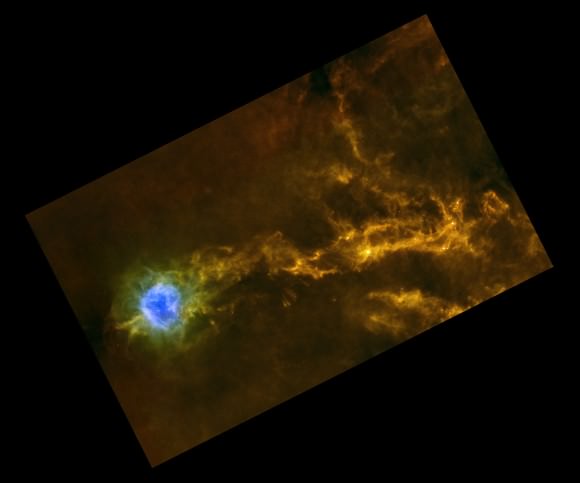‘Sonic Booms’ in Space Linked to Star Formation

Dense filaments of gas in the IC5146 interstellar cloud. This image was taken by ESA’s Herschel space observatory at infrared wavelengths 70, 250 and 500 microns. Stars are forming along these filaments. Credits: ESA/Herschel/SPIRE/PACS/D. Arzoumanian (CEA Saclay) for the “Gould Belt survey” Key Programme Consortium.
Its true there is no sound in empty interstellar space, but the Herschel space observatory has observed the cosmic equivalent of sonic booms. Networks of tangled and tremendously large gaseous filaments seen within clouds of gas and dust between stars are likely to be remnants of slow shockwaves from supernovae, Herschel scientists say. And surprisingly, no matter what the length or density of these filaments are, the width is always roughly the same, about 0.3 light years across, or about 20,000 times the distance of Earth from the Sun. This consistency of the widths demands an explanation, scientists say.
And it’s possible these shockwaves could generate sound within an interstellar cloud – if something were there to hear it.
“Although the density in an interstellar cloud is lower than in a very good vacuum on Earth there are molecules in the order of 10^8 per cm^3” said Goeran Pilbratt, ESA’s Herschel mission scientist. “That should be enough for sound to propagate, apart from the fact that we do not have the instruments to measure it.”
Filaments like this have been sighted before by other infrared satellites, but they have never been seen clearly enough to have their widths measured. Herschel is seeing that the width of these filaments is nearly uniform across three nearby clouds: IC5146, Aquila, and Polaris. The Herschel team, lead by Doris Arzoumanian, Laboratoire AIM Paris-Saclay, CEA/IRFU, made observations of 90 filaments, and found all had nearly identical widths. “This is a very big surprise,” Arzoumanian said.

The network of interstellar filaments in Polaris as seen by Herschel. Credits: ESA/Herschel/SPIRE/Ph. André (CEA Saclay) for the Gould Belt survey Key Programme Consortium and A. Abergel (IAS Orsay) for the Evolution of Interstellar Dust Key Programme Consortium.
Also, newborn stars are often found in the densest parts of these filaments. One filament imaged by Herschel in the Aquila region contains a cluster of about 100 infant stars.
The Herschel team said their observations provide strong evidence for a connection between interstellar turbulence, the filaments and star formation.
“The connection between these filaments and star formation used to be unclear, but now thanks to Herschel, we can actually see stars forming like beads on strings in some of these filaments,” said Pilbratt.
Comparing the observations with computer models, the astronomers suggest that filaments are probably formed when slow shockwaves dissipate in the interstellar clouds. These shockwaves are mildly supersonic and are a result of the huge amounts of turbulent energy injected into interstellar space by exploding stars.
They travel through the dilute sea of gas found in the galaxy, compressing and sweeping it up into dense filaments as they go. As these “sonic booms” travel through the clouds, they lose energy and, where they finally dissipate, they leave these filaments of compressed material.
Interstellar clouds are usually extremely cold, about 10 degrees Kelvin above absolute zero, and this makes the speed of sound in them relatively slow at just 0.2 km/s, as opposed to 0.34 km/s in Earth’s atmosphere at sea-level.
Sound travels in waves like light or heat does, but unlike them, sound travels by making molecules vibrate. So, in order for sound to travel, there has to be something with molecules for it to travel through. On Earth, sound travels to your ears by vibrating air molecules. In deep space, the large empty areas between stars and planets, there are no molecules to vibrate.
Read the team’s paper: Characterizing Interstellar Filaments with Herschel in IC5146
Sources: ESA email exchange with Pilbratt